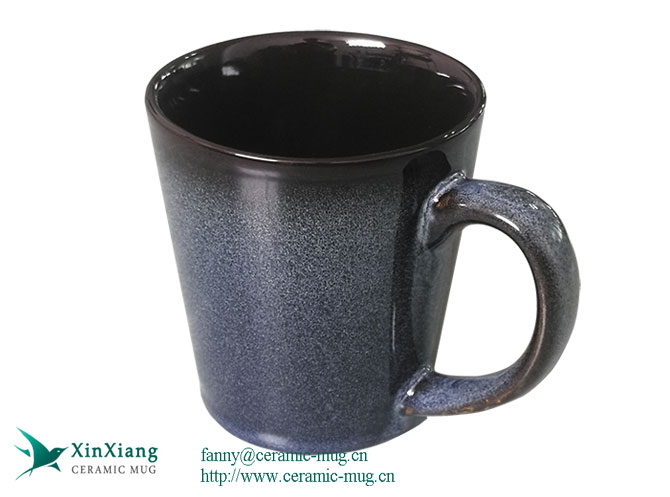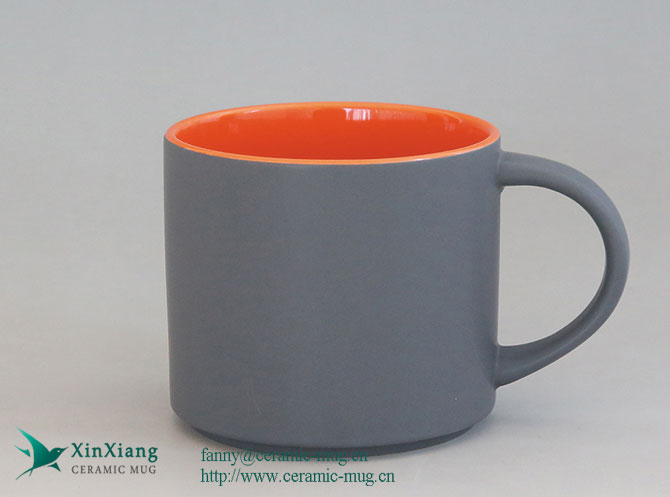Xin xiang Ceramic Mug Manufacturer, Ceramics is a collective term for pottery and porcelain, and ceramics can be used as handicrafts, daily necessities and industrial supplies. As far back as the Neolithic era, China has a rough, simple style of colored pottery and black pottery. Pottery and porcelain have different textures and properties. China's ceramics industry has a long history of development and has flourished over thousands of years, from the Neolithic Age to modern times.
1. History
In the Neolithic era, China has a rough, simple style of colored pottery and black pottery. By the Shang Dynasty (sixteenth - eleventh centuries B.C.) glazed pottery and hard-glazed pottery, which had begun to take on the nature of porcelain, had already appeared. By the Wei and Jin Dynasties (220-420 A.D.), China had already accomplished the major invention of firing porcelain with a high degree of heat to produce a solid texture. During the Tang Dynasty (618-907 A.D.), the production technology and artistic creation of ceramics reached a high level. Exported to Japan, India, Persia and Egypt, played an important role in international cultural exchanges, won the "porcelain country". Ming and Qing dynasties (AD 1368-1911) ceramics from the billet, decoration, glazing to firing, technology and more than the previous generation.
The history of Chinese ceramics development is long. Starting from the early Neolithic period when the most primitive pottery was fired to the invention of porcelain and its universal application, both technology and art have been progressing; in the process of adapting to the needs of people's survival and life, the types of ceramic objects fired have been increasing, the styles have been changing, and the intrinsic qualities have been improving. Ceramic objects of handicraft manufacturing technology, contains a rich scientific and artistic connotation, its expression is mainly through the shape and decoration, texture and color show. Ceramic production from raw materials to the transformation process of finished objects, must use the corresponding technology to complete, this is the process of people producing material materials, but also the creative development and the gradual formation of traditional crafts process.
From the history of the development of ancient Chinese ceramics, ceramic culture can be seen in the era of characteristics: the Qin and Han bold, Sui and Tang's majestic, Song Dynasty Confucian, Ming and Qing Dynasty exquisite, all in their respective historical stages, flashing the flame of its own time.
1.1 Neolithic period
The colored pottery of the Neolithic period has a very proper shape, dense body, fine and unrestrained decorations, beautiful patterns, varied forms, unique artistic style, practical and rich cultural flavor.
1.2 Han Dynasty
By the Eastern Han Dynasty, mature porcelain had been fired. Three Kingdoms, two Jin and North and South Dynasties period of ceramics to "ancient and simple, simple and sparse, rich in heavy decorative flavor" as its distinctive features.
1.3 Tang Dynasty
Tang Dynasty, is the Chinese civilization and West Asia, the East Pacific Islands civilization and the Arabian, Mediterranean civilization mingled period. Tang Dynasty ceramics is famous for its "broad and fresh, thick and powerful, gorgeous and full" artistic style.

1.4 Song Dynasty
Song Dynasty is a period of national rationalization on the fruits of exchanges between Chinese and foreign civilizations. It is also one of the most representative stages in the history of Chinese culture, in which all kinds of foreign things were absorbed and digested, and turned into the physical space where Chinese people could see, live, play and travel. Cultural style became fresh, delicate, rational and fantastical, and heavy on reality. Song Dynasty, is the era of China's porcelain industry flourished. There were the famous "Ding, Ru, official, Brother, Jun" five kilns, but also the magnetic state kiln, Jizhou kiln, Longquan kiln and Jingdezhen kiln (Hutian kiln). Song Dynasty ceramics are famous for the cultural characteristics of "light and subtle, dignified and elegant, quiet and elegant".
1.5 Ming Dynasty
Ming Dynasty ceramics were fully developed, Longquan celadon, Dehua white porcelain, Shiwan Guangjun, Yixing purple sand, Shanxi enameled porcelain are famous, ceramic varieties, colorful, unique style. Ming Dynasty ceramics to "thick, dignified, rich in rich decorative beauty, fun, beautiful" style and independent of the forest of art and culture.
1.6 Qing Dynasty
Qing Dynasty ceramics, is another peak of the development of Chinese ceramics, a variety of varieties, materials, complete, especially in the colored porcelain achievements. Qing Dynasty ceramics to "delicate and gorgeous, quality fine art heavy, exquisite and gorgeous" and famous.

2. Development
2.1 Neolithic Age
The emergence and development of ceramics, in fact, is closely linked with people's lives and production practices, in about 700,000 years ago in the primitive era, people drying mud with fire grill hard containers used for water, storage of food and so on, this is the initial generation of pottery. The latest archaeological data show that the earliest pottery site found in China is located in Jiangxi Wannian County in the immortal cave site, Guangdong Yingde Qingtang, Lingshan slippery rock cave, Guangxi Guilin ZhenpiPiYan. Its main varieties include gray pottery, colored pottery, black pottery and geometric printed pottery, etc., with rough techniques and novel and smooth compositions, showing the technical level of pottery making at that time.
2.2 The Xia to the Two Jin Dynasties
In the ruins of Yinxu of the Shang Dynasty, a lot of pottery pieces and various styles of pots were unearthed, and the decorations, symbols and characters on these pots were closely related to those of the oracle bone inscriptions and the blue wares of the Yin and Shang Dynasties, and the pots were no longer confined to containers at this time, and were widely used, which could be roughly classified into daily necessities, architecture, martyrdom and sacrificial gifts, and so on. After the Qin and Han Dynasties, ancient buildings were mostly constructed with wood, which was not easy to survive for a long time, so some great buildings, such as the Afang Palace in the Qin Dynasty and the Weiyang Palace in the Han Dynasty, could not be preserved in their entirety, but relics such as tiles and bricks can still be found in the remaining ruins, which can give a glimpse of the scale of the ancient buildings. The two Han Dynasty, glazed ceramics replaced a large number of copper daily necessities, so that the rapid development of pottery, due to the mastery of the processing skills, followed by the emergence of vivid and lively patterns and shapes of ceramic decorations, with high artistic value, which is the transition from pottery to porcelain bridge. Two Jin period to the North and South Dynasties ceramics main achievement is mainly reflected in the Yue Kiln, mainly celadon decorated with a high level of art.
2.3. Sui, Tang and Five Dynasties period
Sui dynasty is short, but in the porcelain firing, but there are new breakthroughs, not only celadon firing, white porcelain also has a good development, in addition to this time in the decorative techniques have been innovative, such as in the artifacts in addition to the clay piece of an appliqué, is an example. To the Tang Dynasty, porcelain production can be metamorphosed to the mature realm, and cross into the real porcelain era, because the pottery and porcelain separate, care about the quality of white hard or translucent, and the biggest key to the temperature of the fire, the Han Dynasty produced porcelain, but the temperature is not high, the texture of the fragile can only be regarded as the original ceramics, and the development of the Tang Dynasty, not only the glaze development of the medicine is mature, the fire temperature to reach Celsius more than 1,000 degrees Celsius, so we say that the Tang Dynasty was really into the porcelain generation.
2.4. Song and Yuan Dynasties
Porcelain industry in the Song Dynasty with the emergence of new kilns around the continuous development, the emergence of a number of famous kilns, the so-called five kilns - Ding, Ru, the official, brother, Jun is the representative of the Song Dynasty to form a variety of colorful and beautiful and simple shape, decorative methods of diversified features. The official and private kilns famous porcelain styles are different, a hundred flowers compete, each showing the beauty of a unique style. Yuan Dynasty period there are new developments, such as the rise of blue and red glaze, a large number of colored porcelain popular, driving the development of porcelain after the Ming and Qing dynasties.
2.5 Ming and Qing dynasties
China's pottery development to the Ming Dynasty and into a new journey, before the Ming Dynasty porcelain to celadon mainly, and after the Ming Dynasty to white porcelain, especially blue and white porcelain, five-color became the main products of the Ming Dynasty white porcelain, at this time the tire also tends to be thin, fine, white needs, in the billet body to remember the styles have also begun to date, the age, the hall number, the name of the people have, so that the study of the evidence to have a more accurate identification.
Qing dynasty Chinese porcelain can be said to be the peak of the early Qing dynasty porcelain production technology is highly skilled, fine and gorgeous decorations, the Qing dynasty colored porcelain in the Ming dynasty on the basis of a great development, technological innovation, differentiation of more color, ink color, blue color, gold color also appeared in the five-color porcelain picture, the color of the light and elegant is the characteristics of its, thus enriching the decoration of porcelain in the Qing dynasty.
2.6 Modern pottery
In the production of modern ceramics, the raw materials are taken in an eclectic way. Combination with a variety of materials, and use, penetration, produced a complementary artistic effect, so that modern pottery has both rich expressive and fully coordinated, surface decoration and spatial processing also ascended to a higher level. Modern pottery focuses on texture performance, not to pay attention to whether it is rough or fine raw materials, materials are no longer limited to porcelain clay and pottery clay, but intentionally break through the use of traditional ceramic raw materials, the use of different characteristics of clay, to play a variety of materials of the potential beauty, as long as the kiln can be fired by the mud, sand and other materials can be used in the service of the.
|

